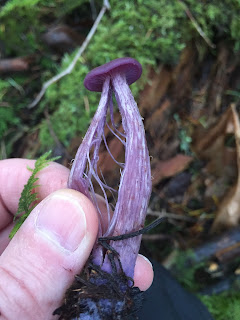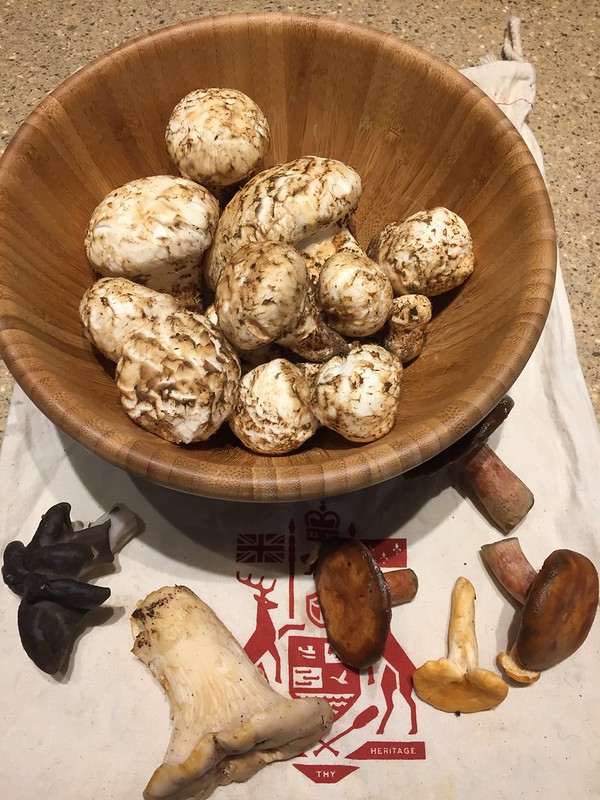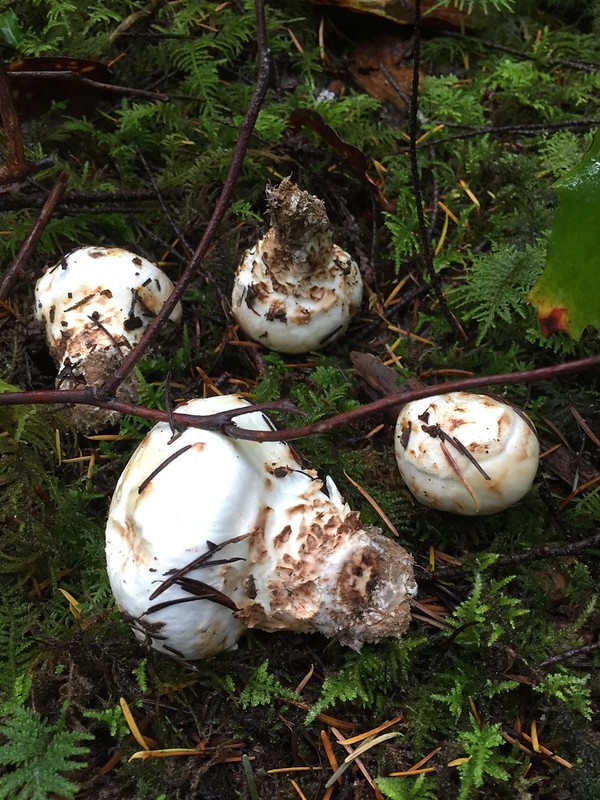100 Mushrooms on Vancouver Island
Saturday, November 5, 2016
Laccaria amethysteo-occidentalis
Yesterday I saw a variety of interesting mushrooms, including a beautiful specimen of what I believe is Laccaria amethysteo-occidentalis.
Labels:
Laccaria amethysteo-occidentalis,
Nanaimo
Location:
Nanaimo, BC, Canada
Saturday, October 29, 2016
First Pines Near Nanimo
Same forest near Nanaimo, very large and waterlogged White Chanterelles, Firm and no bugs on the Red Juice Milky Caps, and lots of Elfin Saddle. First two Hedghogs I've found near Nanaimo this year.
Above lower left, the one White Chanterelle that I brought home. Even when they were newly emerged (last two weeks?) like this one, most were too waterlogged to bring home.
Above lower left, the one White Chanterelle that I brought home. Even when they were newly emerged (last two weeks?) like this one, most were too waterlogged to bring home.
Monday, October 10, 2016
Golden Chanterelles are out Near Campbell River
Spent an enjoyable day wandering through some mushroom patches I scoped out two years ago in the Sayward Forest near Campbell River. Found lots of Golden Chanterelles at all stages of development, so I would say we are early to mid season on the North Island. I haven't seen any in my usual haunts near Nanaimo, so suspect we are a week or two behind. Here is a video from today, and a few photos.
Sunday, October 9, 2016
Last of the Whites for 2016
Spent a pleasant day yesterday wandering through the local forest where I've been picking White Chanterelles all summer, to find most of them now too mushy for keeping -- but I did find a few keepers. No Goldens yet, in that patch of woods. Heading up Island tomorrow to see what I can find. Here is a video of some of the finds yesterday:
Labels:
Chanterelles,
Nanaimo,
vancouver island,
White Chanterelle
Saturday, September 10, 2016
The White and the Blue
I've seen blue mould on mushrooms over the years and generally I just leave them in the field to do their thing, i.e. reduce the mushroom to a dead dark lump. But I heard from a mushrooming veteran that the blue moulds are only skin deep, so you can cut away the mouldy portions and eat the rest. Anyone know if this is true for sure?
Labels:
Blue Mould,
Nanaimo,
vancouver island,
White Chanterelle
Sunday, July 10, 2016
First White Chantrells
The unusual amount of rain this June brought out a flush of many different mushrooms that I don't normally see till late August or early September, including one of my favorites, the white Chanterell. Here is a video from today's walk in the forest above Nanaimo.

Russula Rosacea or Russula xerampelina?

White Chanterelle (Cantharellus subalbidus)




White Chanterelle (Cantharellus subalbidus)


Tuesday, July 5, 2016
June Mushrooms
On the weekend I saw a Rosy Rusella and puffball mushrooms, and today my first Lobster.










Location:Nanaimo, Canada
Wednesday, March 9, 2016
Informative Article on Cooking Store Bought Mushrooms
This article by Lauren Hudgins is an excellent introduction to mushrooms that can frequently be found in the suppermarket, including some wild foraged ones.

http://www.seriouseats.com/2015/06/mushroom-shopping-guide.html
http://www.seriouseats.com/2015/06/mushroom-shopping-guide.html
Saturday, October 31, 2015
Large Fluted Black Elfin Saddle and a Sweet Patch of Sweet Tooth
It is hard to believe that I could love the Sayward Forest, just north of Campbell River, any more than I already do. I've been enjoying it from the canoe for years, and over those years I have gazed at certian forests thinking, "I'll have to come back here in mushroom season." This year I did.
In the above video I ramble for a bit about the type of forest, then show some truely MASSIVE Elfin Saddles, a nice patch of Hedghogs, and more.
Here is a video just of the Hedghog Patch:
And just of the Elfin Saddles:
I'm really interested to hear from anyone who has eaten Elfin Saddles, how you cook them, and if it is worth it. Some smell delicious, some don't -- Why is that?
Thanks!
Here is a video just of the Hedghog Patch:
And just of the Elfin Saddles:
I'm really interested to hear from anyone who has eaten Elfin Saddles, how you cook them, and if it is worth it. Some smell delicious, some don't -- Why is that?
Thanks!
Labels:
Black Fluted Elfin Saddles,
Campbell River,
Helvella lacunosa,
Pacific Golden Chanterelle,
Sayward Forest,
vancouver island
Wednesday, October 28, 2015
The Secret to Delicioius Chanterelle Mushrooms
I remember the first time I tasted a wild mushroom. It was a Giant Puffball that my father had rescued from us children.
"Oh, hold on!" my dad called, and something in the tone in his voice made us stop. Someone, not me, one of the other kids I'm sure, was winding up for a kick at the baseball sized mushroom. Dad plucked it, took it in the house, cut it into "steaks" and fried the steaks in butter till they were golden and almost black around the edges. He handed me one of the slices on a plate with a fork and I sniffed it wearily. Then I took a bite. I never looked back.
I was 12 when that happened and I've been frying wild mushrooms in butter ever since. But I have to say there are a few things that help mushrooms shine. A fine olive oil is as good as butter, the right cheese, garlic for some types, onions for most, and for Chanterelles, a good rich Cabernet Sauvignon.
Here is my recipe:
"Oh, hold on!" my dad called, and something in the tone in his voice made us stop. Someone, not me, one of the other kids I'm sure, was winding up for a kick at the baseball sized mushroom. Dad plucked it, took it in the house, cut it into "steaks" and fried the steaks in butter till they were golden and almost black around the edges. He handed me one of the slices on a plate with a fork and I sniffed it wearily. Then I took a bite. I never looked back.
I was 12 when that happened and I've been frying wild mushrooms in butter ever since. But I have to say there are a few things that help mushrooms shine. A fine olive oil is as good as butter, the right cheese, garlic for some types, onions for most, and for Chanterelles, a good rich Cabernet Sauvignon.
Here is my recipe:
Monday, October 26, 2015
Matsutake and it's Look-a-Likes
Spend a little time browsing online mushroom forums and you discover that some people are very apprehensive about picking Pine Mushrooms (Tricholoma magnivelare) because they are not easy to distinguish from the plethora of other large white mushrooms found on Vancouver Island and other locations in the Pacific Northwest. Others are cavalier, saying that once you know a Matsutake, you will never mistake it for anything else. I'm somewhere in the middle of these poles.
The biggest fear on Vancouver Island is picking and eating a Smith's Amanita.
I've seen a fair number of Smith's Amanitas in my forays, and have never been tempted to bring one home. The damp cottony or fluffy material that seems to cover them has a strange unpleasant feel and the smell is very off-putting. I have been told, however, that some Smith's Amanitas can smell remarkably like a Pine at different stages of their development, and are most often mistaken when in the button or an early stage of fruiting like the ones pictured on the right below.
Confusing matters for me is that most of the Pines I have found have not had a strong spicy, cinnamony, or "red hot" odor. I knew they were not Smith's Amanita, but since so much is made of their odor, I have wondered if it was my nose, the areas I've found them, or some other factors that make it harder for me to smell that "Matsutaki smell." I had heard there was a close cousin to the Pine in our woods, but had forgotten what it was called. I had this vague idea that maybe that was what I was finding.
The only other mushrooms that came to mind, besides the Smith's Amanita, that might be confused with a Pine were the big Russelas (Cascade and Short Stemmed) and the Death Cap and Destroying Angel. I decided to do some more serious research and find out what the common look-a-likes are and then compile what I find here for future reference.
As suspected, Death Cap, Destroying Angel, and the Russelas are hard to confuse with a Matsutake so I ended up focusing on the 3 Mushrooms most likely to be confused with a Pine Mushroom, the Tricholoma caligatum, Catathelasma ventricosum (and its close cousin the Catathelasma imperiale) and of course Amanita smithiana. I gathered the relevant info in a chart below.
One of the most helpful online resources in my research was was "Matsis and Wannabees: A Primer on Pine Mushrooms by Britt A. Bunyard in Volume 6:4 of FUNGI (2013). This is perhaps the best readily available and readable article I could find. http://www.fungimag.com/winter-2013-2014-articles/LR%20V6I4%20Matsis.pdf
Also very extensive and useful is: http://bcmushrooms.forrex.org/ntfp/pages/trichomagniv/trichomagniv_syn.html
In my research I referenced "Mushrooms of the Pacific Northwest," "Edible Wild Mushrooms of North America: A Field-to-Kitchen Guide," and "Common Mushrooms of the Northwest," as well as the following websites: wikipedia.org, usask.ca, svims.ca, projectnoah.org, .mushroomthejournal.com, and mushroomexpert.com.
Here is a longer up-close HD video of one of my Tricholoma magnivelare as I was not able to find any good quality ones on-line:
The biggest fear on Vancouver Island is picking and eating a Smith's Amanita.
I've seen a fair number of Smith's Amanitas in my forays, and have never been tempted to bring one home. The damp cottony or fluffy material that seems to cover them has a strange unpleasant feel and the smell is very off-putting. I have been told, however, that some Smith's Amanitas can smell remarkably like a Pine at different stages of their development, and are most often mistaken when in the button or an early stage of fruiting like the ones pictured on the right below.
Confusing matters for me is that most of the Pines I have found have not had a strong spicy, cinnamony, or "red hot" odor. I knew they were not Smith's Amanita, but since so much is made of their odor, I have wondered if it was my nose, the areas I've found them, or some other factors that make it harder for me to smell that "Matsutaki smell." I had heard there was a close cousin to the Pine in our woods, but had forgotten what it was called. I had this vague idea that maybe that was what I was finding.
 |
| Smith's Amanita taken by Joe Anderson, http://www.inaturalist.org/photos/568041 |
As suspected, Death Cap, Destroying Angel, and the Russelas are hard to confuse with a Matsutake so I ended up focusing on the 3 Mushrooms most likely to be confused with a Pine Mushroom, the Tricholoma caligatum, Catathelasma ventricosum (and its close cousin the Catathelasma imperiale) and of course Amanita smithiana. I gathered the relevant info in a chart below.
One of the most helpful online resources in my research was was "Matsis and Wannabees: A Primer on Pine Mushrooms by Britt A. Bunyard in Volume 6:4 of FUNGI (2013). This is perhaps the best readily available and readable article I could find. http://www.fungimag.com/winter-2013-2014-articles/LR%20V6I4%20Matsis.pdf
Also very extensive and useful is: http://bcmushrooms.forrex.org/ntfp/pages/trichomagniv/trichomagniv_syn.html
In my research I referenced "Mushrooms of the Pacific Northwest," "Edible Wild Mushrooms of North America: A Field-to-Kitchen Guide," and "Common Mushrooms of the Northwest," as well as the following websites: wikipedia.org, usask.ca, svims.ca, projectnoah.org, .mushroomthejournal.com, and mushroomexpert.com.
Pine Mushrooms and Their Look-a-Likes
| Common Name | Pine Mushroom, Matsutake |
Fragrant Tricholoma, Fragrant Boot, Booted tricholoma, Fragrant Armillaria | Cat, Big Cat, Imperial Cat | Smith's Amanita |
| Scientific Name |
Tricholoma magnivelare | Tricholoma caligatum (formerly - Armillaria caligata) | Catathelasma ventricosum and Catathelasma Imperiale | Amanita smithiana and Amanita silvicola |
| Main Distinction from a Pine Mushroom | There appears to be a growing concensus that the mushroom we call a Pine here on Vancouver Island is Tricholoma magnivelare and that it is different from Tricholoma matsutake. The similarities are, however, so striking that for our pruposes we can call our Pine a Matsutakes. |
Generally more brown with more fibrils on the
cap Smaller cap when mature Boot shaped fibrous veil (sometimes) highly variable taste, usually bitter Less common |
Double veil and amyloid spores. (Double veil
can be hard to distinguish More grey or brown than white No spicy odor Prefers Spruce Larger -- can have caps that are a foot across when fully mature (Imperiale) Both are rare on Vancouver Island |
Usually ghostly white, with a more slender
stipe, and covered in fluffy ragged patches and warts Firm, but not as firm as a Pine Mushroom and not as likely to pull apart like string cheese. Usually smells different than a Pine, unpleasant. |
| Cap | Dry Mostly White Smooth, sometimes with faint scale-like brown splotches. Others describe as "slightly shaggy" Occasionally grey or brown in colour all over Cap edge is in-rolled 5 - 20 cm or larger |
Dry Mostly brown (light to deep brown to chestnut) surface over white Others describe the colour by refering to the prominent dark brown vinaceous fibrils that cover white flesh, sometimes separating in age to reveal the whitish or pinkish flesh beneath. Cap edge is in-rolled 4 - 12 cm across Sometimes with remnants of the partial veil attached, most of which remains as a ring. |
Generally dry but Imperiale can be sticky
with young. Brownish to grey. Cap edge has a strongly in-rolled margin 5 - 15 cm (ventricosum) 5 - 40 cm (Imperiale) |
Moist or dry White with cotton -like warts Punky Often presence of clingy cottony remnants of veil hanging from edge of cap 12 - 20 cm across or 5 - 17cm across (depending on age) |
| Gills | White to cinnamon coloured with age Tricholoma means it has notched (adnexed) gills, white spores, and is mycorrhizal (symbiotic relationship with photosynthesizing plants/trees) |
White, becoming spotted brown with age Tricholoma means it has notched (adnexed) gills, white spores, and is mycorrhizal (symbiotic relationship with photosynthesizing plants/trees) |
Long, decurrent, crowded, narrow Extend down stipe |
White to cream coloured sometimes pinkish,
closely crowded, floccose edges free to narrowly adnate, sometimes with a faint decurrent line on stem apex, close to crowded |
| Spores | White | White | White, amyloid | White |
| Stipe | Firm Pointed at the base White above ring white below ring but often with brown streaked areas Sometimes expanded at base Usually grey soil and fibrals at base |
Firm Pointed at the base White but often also covered with brown fibrils or reddish brown spots (with age) |
Firm Pointed at the base |
Firm, but generally not as firm as Tricholoma
magnivelare White, usually above and below ring. veil leaves soft powdery or cottony covering. Generally thickening towards base but can be pointed at base or club shapped Can have Often grey soil at base. |
| Veil | Thick membranous Sheaths the stipe, white at first, forming prominent cottony ring that flares out at first, then collapses against stem when old |
Stipe below the ring often bears brown fibrils like those on the cap, giving the mushroom the appearance of wearing a boot, hense, caligatum (Latin for boot) | has two viels, an inner one that leaves a ring on the upper stipe, with one lower down as well. | shaggy cotton-like remnant remains on young speciments, leaves a fragile, ragged ring that easily falls off. |
| Habitat | Conifer forests |
Conifer forests | Under sitka spruce, western hemlock &
Douglas fir Usually in calcareous soils forming arcs or rings of fruiting bodies |
Conifer forests, also alder and mixed forests Can be soil or well-rotted wood |
| Odor and Taste | distinctly spicy-aromatic. "organic (not earthy or mushroomy) smell" |
Usually reported to be unpleasant in
the PNW. Sometimes claimed to have a similar odor to
magnivelare. Some claim it is a minder smelling mushroom while others claim caligatum is more cinnamony. |
Has a strong farinaceous odor and taste. A
common mushroomy smell like that of cucumbers, watermelon
rind, or an old grain mill "tastes mealy" - http://www.mushroomexpert.com/catathelasma.html |
Not spicy, often described as chlorine like,
often as unpleasant. Also described as mild to pungent. A number of reports say it smells similar to a Pine Mushroom. |
| Edibility | "...sometimes edible and good, but sometimes very bitter and foul tasting." - Tom Volk | |||
| Indicator Species | Candystick (Allotropa vigata) or Booted Knight (tricholoma focale) | |||
| Notes | Stipe peels somewhat like string cheese. Usually distributed in clusters on the narrow mountain ridges and southfacing slopes. |
"Another similar species, the booted
tricholoma..., can be found mixed with pine mushroom at
buying stations in British Columbia (Marty
Kranabetter, B.C. Ministry of Forests, and Tyson Ehlers,
Tysig Ecological Consultants, pers. comms., 2000)"- BC
Journal of Ecosystems and Management Is the booted
tricholoma in British Columbia really Japanese matsutake? A California version of Tricholoma caligatum (sensu Shanks, 1994) grows under conifers from "November to December in northern coastal forests and low elevation montane forests of the Sierra Nevada"; it is extremely bitter. Given its widely different mycorrhizal associations, it may well be a distinct species. I have collected a mild-tasting form of Tricholoma caligatum under spruce and fir in the Rocky Mountains. - http://www.mushroomexpert.com/tricholoma_caligatum.html "Tricholoma caligatum smells weakly of matsutakes and indeed is often collected and eaten as such." - Britt A. Bunyard "There are more and darker (purplish-brown) fibrils or scales on the cap and stipe of T. caligatum, which is smaller and less robust [than magnivelare]. Its aroma also has a sharper, cinnamon candy (Red Hots) component lacking from the pine mushroom’s musty and spicy smell." - http://bcmushrooms.forrex.org/ntfp/pages/trichomagniv/trichomagniv_syn.html |
There are two species, both occure in the
Pacific Northwest, Cathathlasma ventricosum (pale grayish
cap) and C Imperiale (brown Cap) No official confirmation it occurs on Vancouver Island |
Often tall stature and "ghostly
white all over" Warts can become tan colored when dried out Usually appears to have a ragged scaly stem with spindle-shaped bulb that is often rooting Very common An old specimen can look quite different from a fresh one "Amanita smithiana has free gill attachment and being from section Lepidella, it is quite powdery. The texture of the flesh should be pretty different as well. Matsutake has a pretty stringy texture, while Amanitas can not be peeled like string cheese." |
Here is a longer up-close HD video of one of my Tricholoma magnivelare as I was not able to find any good quality ones on-line:
Monday, October 19, 2015
Matsutake
The Matsutake here on Vancouver Island is the Tricholoma magnivelare. It is most often confused with Tricholoma caligatum and Catathelasma ventricosum. Caligatum is bitter and odorless, and ventricosum has gills that run down the stem. The only non-edible mushroom an experienced forager is likely to confuse with the Matsutake is Smith's Amanita, a poisonous mushroom that often causes kidney failure.
Today I found my first Matsutake of the season.
Here are a few choice links from others on the Matsutake:
From Mike Orr:
An interesting video from David Pilz - Mycologist: https://vimeo.com/16682565
Great article on cooking Matustake: http://honest-food.net/2012/12/19/matsutake-mushroom-recipe/
Today I found my first Matsutake of the season.
Here are a few choice links from others on the Matsutake:
From Mike Orr:
An interesting video from David Pilz - Mycologist: https://vimeo.com/16682565
Great article on cooking Matustake: http://honest-food.net/2012/12/19/matsutake-mushroom-recipe/
Friday, October 16, 2015
Just came across this modest and uncluttered but extremely helpful site about easy to identify edible mushrooms in BC. Truly capital. I will have to add it to my links sidebar...
http://northernbushcraft.com/mushrooms/index.htm
Sunday, October 11, 2015
Still Nothing in Nanaimo, but Up-Island it is Well in to the Season
I drove today to a spot near Port Alberni that I have been speculating about for some time. This was a new area so I had no idea what I would find. Within a few minutes hiking I found many bleeding milk cap (Lactarius rubrilacteus) and then a patch of Golden Chanterelles, and some Hedghogs.
Here is a video I took. In it I say that the Golden Chanterelles are just starting, but I did find several patches that were very mature, and most of them had been invaded by a white fibrous mold. I have not seen that before. Other patches of younger specimens were very firm and fresh.
A little further on I found some Hedgehogs.
Lastly I found some Elfin Saddles (Helvella) -- Maybe this year I will actually try eating some...
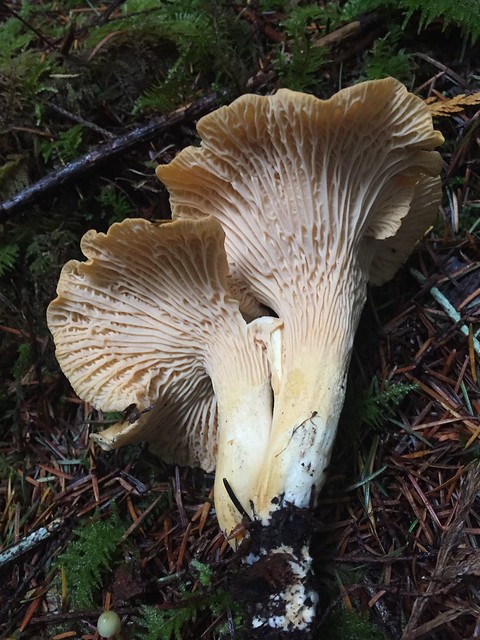 |
| Golden Chanterelle |
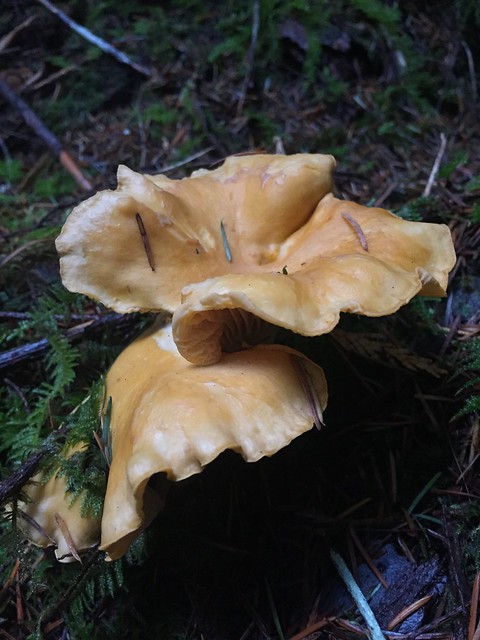 |
| Golden Chanterelle |
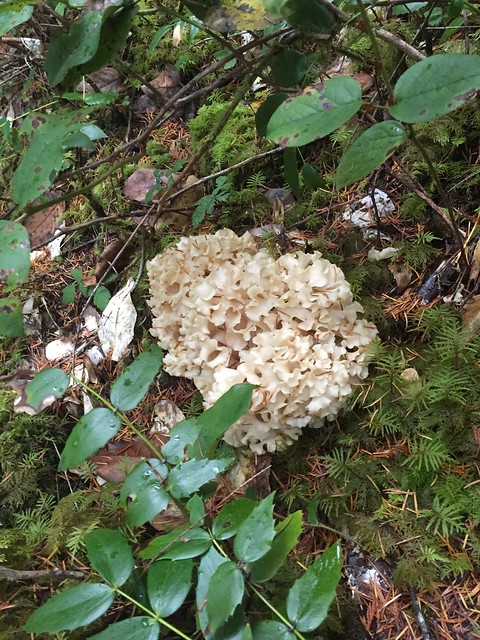 |
| Cauliflower Mushroom |
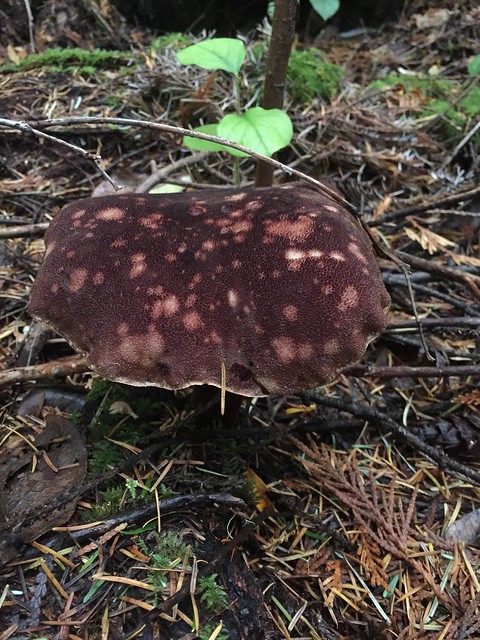 |
| Admirable Bolete |
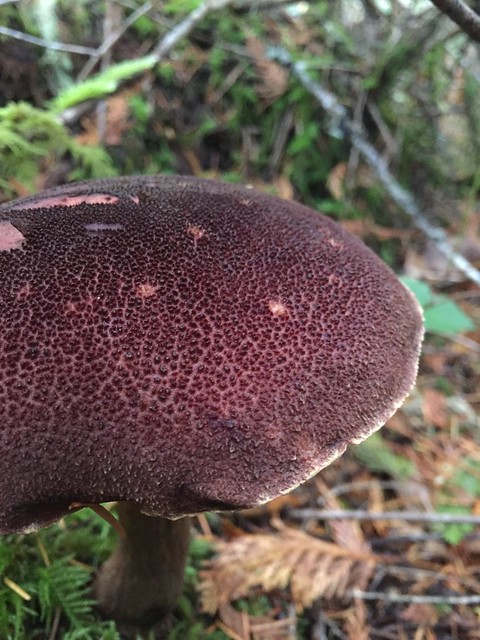 |
| Admirable Bolete |
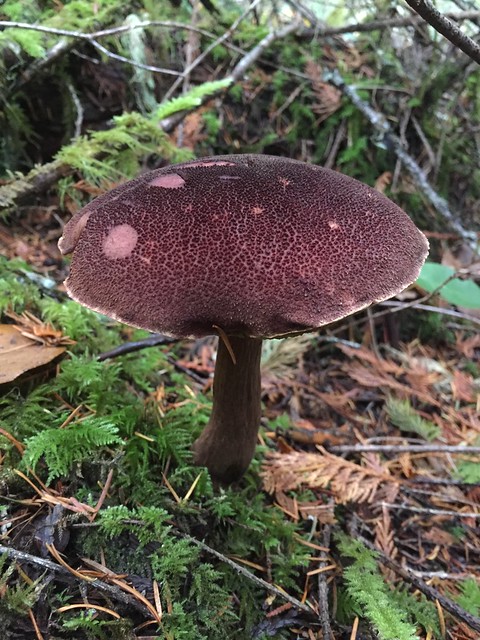 |
| Admirable Bolete |
Here is a video I took. In it I say that the Golden Chanterelles are just starting, but I did find several patches that were very mature, and most of them had been invaded by a white fibrous mold. I have not seen that before. Other patches of younger specimens were very firm and fresh.
A little further on I found some Hedgehogs.
Lastly I found some Elfin Saddles (Helvella) -- Maybe this year I will actually try eating some...
Labels:
Admirable Bolete,
Boletus mirabilis,
Hedghog,
hydnum rapandum,
hydnum umbilicatum,
Mushrooms,
Pacific Golden Chanterelle,
Sarassis crispa
Friday, September 25, 2015
After finding no mushrooms yet in the Nanaimo area I happened to be up island north of Qualicum and came across these specimens.
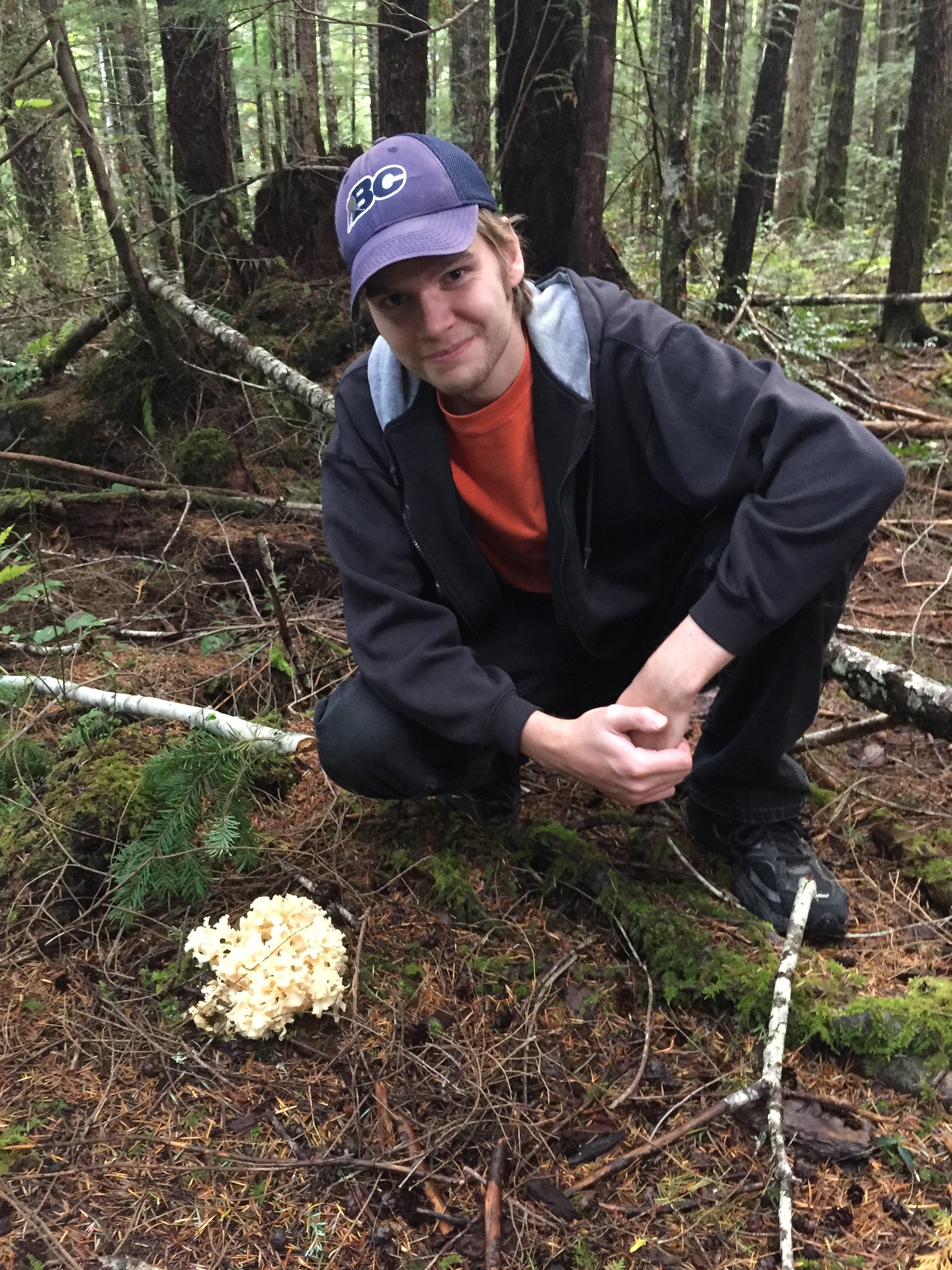
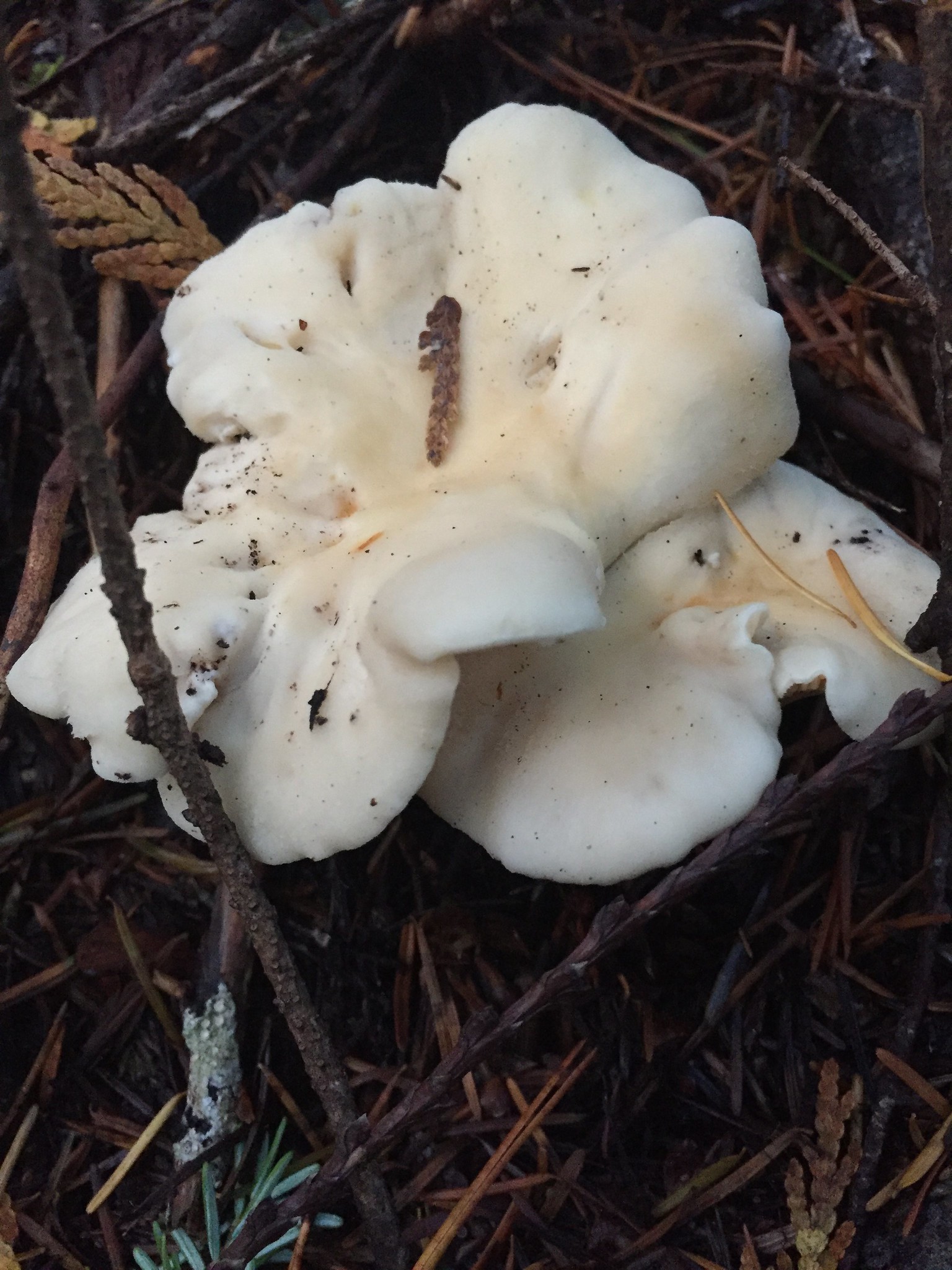
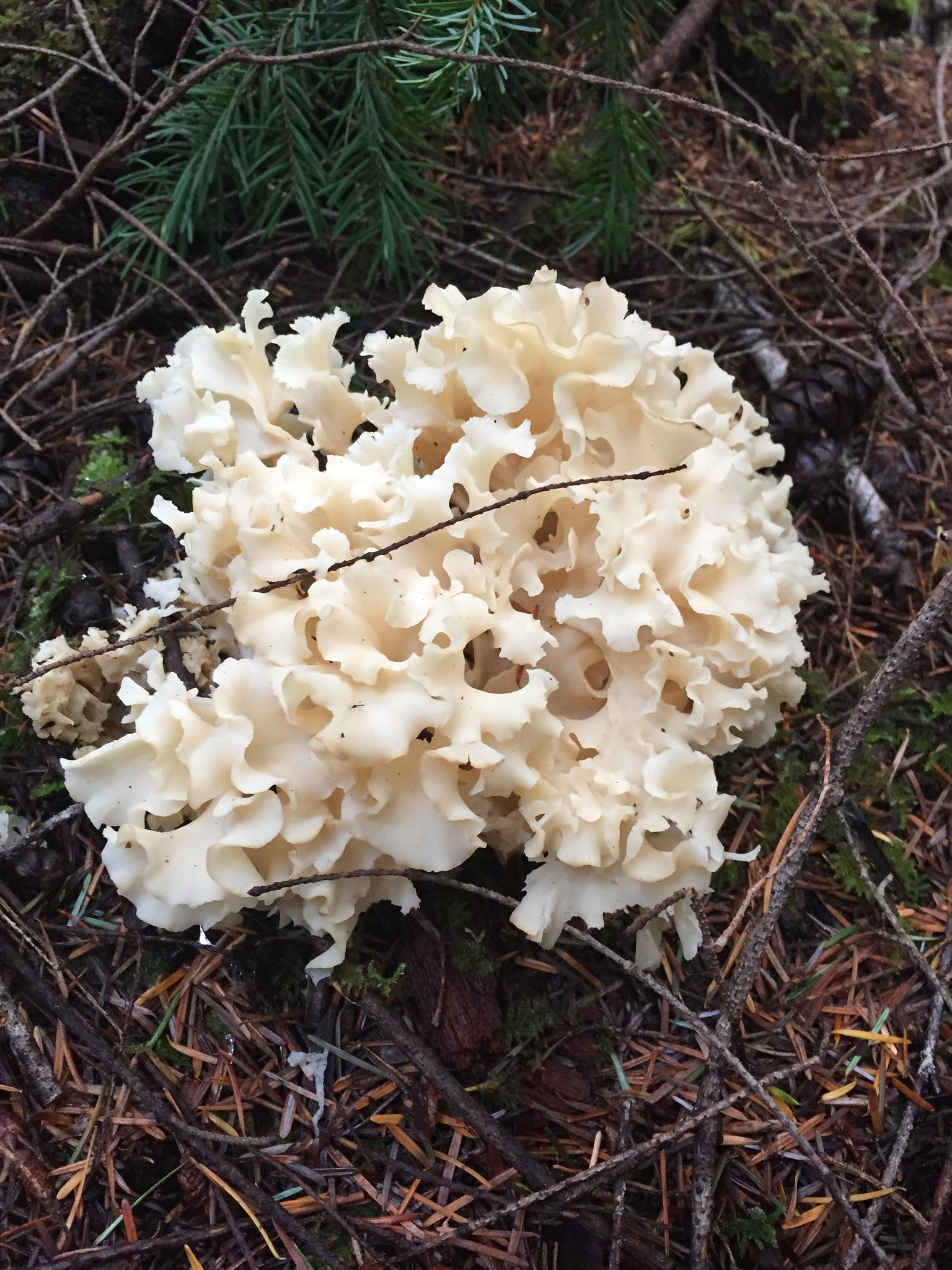 | ||||
| Cauliflower Mushroom 25 Sept 2015 |

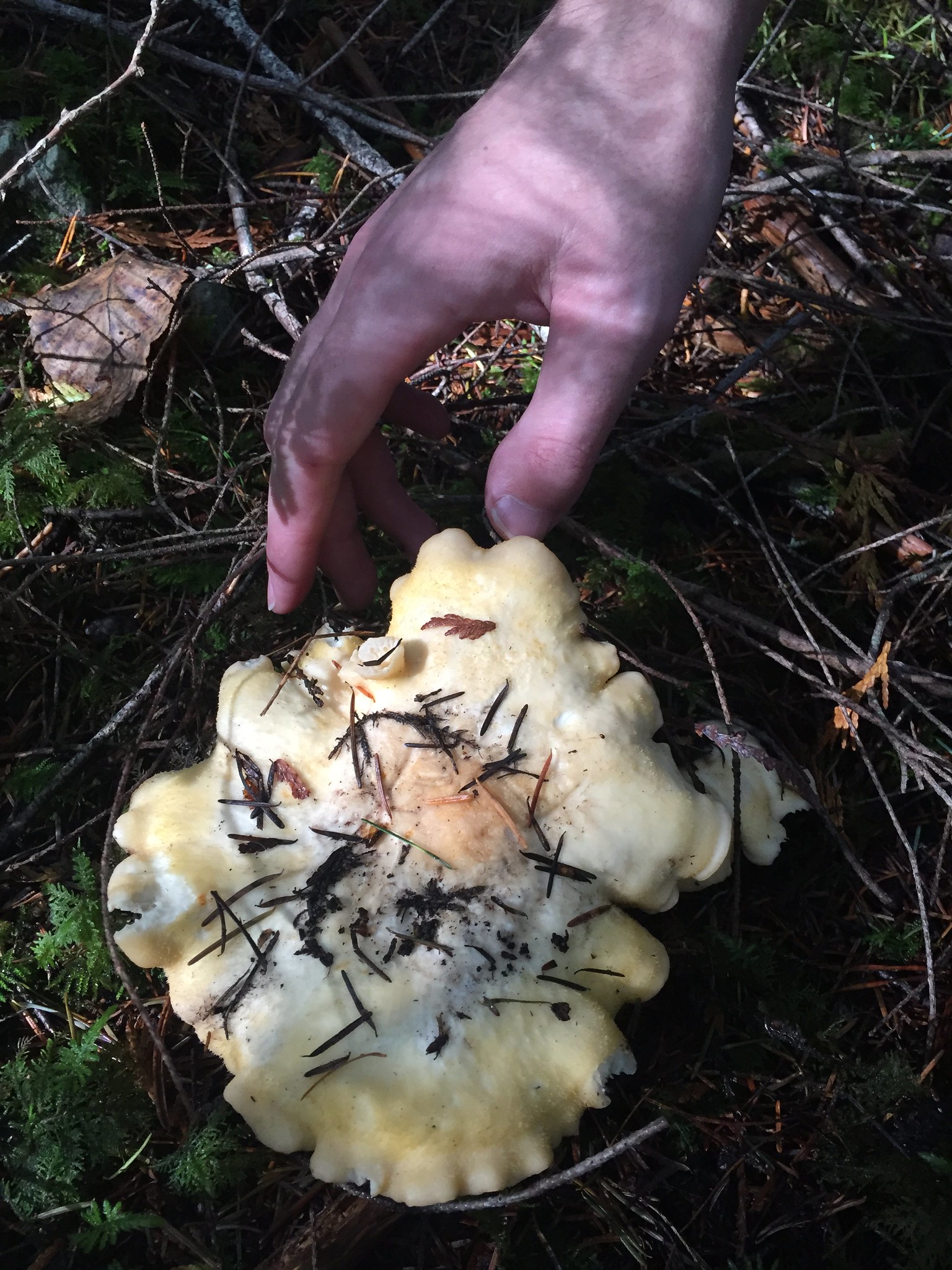 |
| White Chanterelle 25 Sept 2015 |

Saturday, November 15, 2014
Wednesday, November 12, 2014
Is the Admirable Bolete really that Admirable?
Well, yes actually, it is a very admirable bolete. Many say it is second only to the King Bolete in our area, but I wouldn't know because I've never found a King. Jessica Wolf says she just found a Queen Bolete. Lucky girl. So far, for me, Boletus mirabilis is the best boletus I have tasted.
Mostly in the past I've seen it growing on old stumps and very well decomposed logs. Like this one:
But this year they are everywhere, on ground which I can only surmise is full of rotting logs and woody mass.
They supposedly love hemlock, so the further up-island the better, but I have found that they like older forests, generally 30 years old or older.
And they tend to pop up in strange places, usually very dense dark woods, although this year, many are on mossy ground usually spotted with Chanterelles.
The above beauty was growing out from between a tangle of roots and sticks.
This one was at the base of a stump.
My video from today showing a variety of the ones I collected today.
And this one of some nice Winter Chanterelles.
Happy hunting!
Mostly in the past I've seen it growing on old stumps and very well decomposed logs. Like this one:
But this year they are everywhere, on ground which I can only surmise is full of rotting logs and woody mass.
They supposedly love hemlock, so the further up-island the better, but I have found that they like older forests, generally 30 years old or older.
And they tend to pop up in strange places, usually very dense dark woods, although this year, many are on mossy ground usually spotted with Chanterelles.
The above beauty was growing out from between a tangle of roots and sticks.
This one was at the base of a stump.
Happy hunting!
Saturday, November 8, 2014
Winter Chanterelles, Elfin Saddle, Bleeding Milk Cap, Admirable Bolete.
Graham and I were out looking for rocks, for a back yard project, and we ended up driving up the Cameron Main because the rivers are all really high, so no accessible rocks. I asked him if I could have 3 minutes to look for mushrooms and the above is what I found, just off the side of the road. How cool is that???
Then I asked him if we could visit another forest where I knew there to be Admiral Boletes from time to time. There had been some pickers there before us as evidenced by cut stipes, but we still found a good number of that most impressive of boletes in our area, but unfortunately all but one was past prime or full of bugs. Gray found two, the below being the largest. Too bad it was so far mature. Jessica Wolf tells me there are still some young ones out there, so planning a short excursion later this week.
Then I asked him if we could visit another forest where I knew there to be Admiral Boletes from time to time. There had been some pickers there before us as evidenced by cut stipes, but we still found a good number of that most impressive of boletes in our area, but unfortunately all but one was past prime or full of bugs. Gray found two, the below being the largest. Too bad it was so far mature. Jessica Wolf tells me there are still some young ones out there, so planning a short excursion later this week.
Friday, October 31, 2014
Fluted Black Elfin Saddle, Golden Chanterelles, Hedgehog
 |
| Helvella lacunosa |
Found these Fluted Black Elfin Saddles today, along with a few Chanterelles and one lone Hedgehog. Was surprised to find the hedgehog!
 |
| Hydnum umbilicatum |
 |
| Golden Chanterelles |
Monday, October 20, 2014
Monday, October 13, 2014
Lots of Boletes, Puffballs, and Slimmy Gomphidius
13 October 2014
Still not sure what this is....
Suillus lakei
Suillus brevipes
Sulfer Tuft?
Gomphidius glutinosus?
Still not sure what this is....
Suillus lakei
Lycoperdon perlatum
Labels:
Gomphidius glutinosus,
Lycoperdon perlatum,
Mushrooms,
Nanaimo,
Suillus brevies,
Suillus lakei,
vancouver island
Subscribe to:
Comments (Atom)

